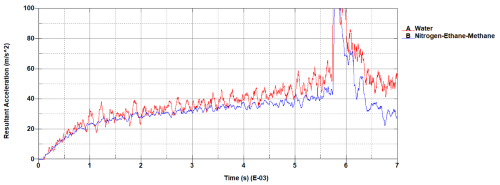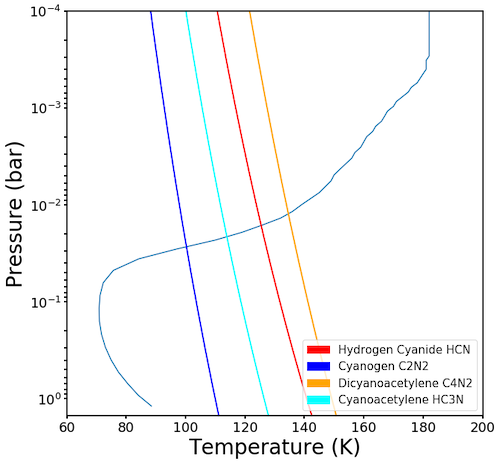Introduction
Key questions surrounding the origin and evolution of Titan and the Saturnian system in which it resides remain following the Cassini-Huygens mission. In-situ measurements performed at key locations on the moon are a highly effective way to address these questions, and the aerial-aquatic platform proposed in this report serves to deliver unprecedented access to Titan's northern surface lakes, allowing an understanding of the hydrocarbon cycle, the potential for habitability in the environment and the chemical processes that occur at the surface. The proposed heavier-than-air flight and plunge-diving aquatic landing spacecraft, ASTrAEUS, requires modelling of the conditions which can be expected on Titan's surface lakes, the initial stages of which are detailed here through the use of multiphysics fluid-structure interaction (FSI) CFD simulations with a coupled meshfree smoothed-particle hydrodynamics (SPH) and finite element method (FEM) approach in LS-DYNA.
Spacecraft
The ASTrAEUS (erial urveyor for itan with quatic Operation for xtended ability) spacecraft provides an aerial-aquatic platform inspired by the flight and ‘plunge-diving’ landing of the gannet sea bird.

Figure 1: Impression of a 'plunge-diving' manoeuvre by an aerial-aquatic aircraft inspired by the gannet seabird (inset). Inset adapted from Liang et al. (2013).
A key and unique benefit of the ASTrAEUS proposal is the ability to make in-situ measurements in various separate bodies of surface liquid on Titan, allowing characterisation of these areas to a level currently unavailable with any planned or proposed mission. Kraken Mare is selected as an initial landing site due to it being Titan’s largest lake and due to its proximity to a number of other lakes of key interest to the scientific community.
Numerical Modelling
This numerical study involves the CFD simulation of a rigid body entering a finite domain free-surface without heat transfer.
A nitrogen-ethane-methane mix, approximated from Kraken Mare and having density ρ=664 kg/m3 and dynamic viscosity of μ=1014 µPas (Hartwig et al. 2018) was used, with the additional gravitational acceleration taken to be g=1.35 m/s (Ori et al. 1998).
The liquid is modelled by an SPH, pure Lagrangian method using meshfree particles and serves to efficiently model situations where large boundary deformations are present, or when a free-surface flow needs to be defined. It acts as the most appropriate for free-surface flow and hydrodynamics problems due to the versatility and simple method of numerical analysis and uses interpolation to compute smooth field variables. It is widely accepted that for problems with large deflections or boundary deformations, an SPH method is more appropriate than the alternative meshed method as it avoids problems such as mesh distortion, mesh tangling and inaccurate modelling due to unrealistic mesh interdependence.
These SPH particles were modelled using the Murnaghan equation of state, which defines the pressure in a fluid as:

where

ρ and ρ0 are the local and global densities respectively, γ is a constant defined as approximately 7 according to the conditions and vmax is the maximum observed velocity in the fluid.
A definition of k0 was presented by J. Monaghan and A. Kos (1999) as

where g is the acceleration due to gravity and H is a characteristic simulation length. Taking the characteristic depth of a test tank as 1 m, k0 takes the value of ~1.2x104, compared to a value of ~1.5x105 for water in the same conditions.
Bulk viscosity controls were placed on the fluid, in the form of the quadratic and linear bulk viscosity coefficients. It was found realistic fluid behaviours were observed with these taking values of 0.015 and the near-zero value of 1x10-12 respectively.
Contact modelling techniques were key in ensuring the accuracy of simulations given the magnitude of the observed boundary deformations. A penalty-based approach to this modelling was taken, where a restoring spring force was applied between the fluid particle and FEM mesh boundary.
The spacecraft quasi-ellipsoid fuselage impact was approximated by a projectile formed by a rotated NACA 0010 aerofoil. A higher resolution was applied to the nose given the increased curvature, with this resolution and the associated computational power being a limiting factor of the simulation. A mesh sensitivity study was used to find the highest possible nose resolution realistically modelled within the computational limitations of the study.

Figure 2: High SPH resolution, double-precision solved solution with nodes travelling over a specific velocity shown and with attached velocity vectors

Figure 3: Projectile deceleration due to water and N/C2H6/CH4 mix
The decelerations experienced by this projectile in both liquid water and the nitrogen-ethane-methane mix were observed. These showed little divergence initially, but increased as the projectile penetrated the fluid surface. It could be expected that the comparative viscosities would mean nitrogen-ethane-methane would demonstrate more inertia to deformation. However, the lower density of this fluid can be seen to have a more dominant effect. The spike in experienced acceleration is caused by the reflected shockwave, having interacted with the simulation limits, returning to the projectile. Therefore results after this are discarded.
For interest and fluid understanding, the respective sloshing behaviours of liquid water and nitrogen-ethane-methane were also modelled.

Figure 4: Wave development and FSI of Kraken Mare liquid and Earth water with velocity displayed. Red corresponds to a higher relative velocity.
Acknowledgements
This work is the result of a research project funded by the Royal Academy of Engineering, the Royal Astronomical Society and the British Interplanetary Society.
References
Hartwig, Jason, Peter Meyerhofer, Ralph Lorenz, and Eric Lemmon. 2018. “An Analytical Solubility Model for Nitrogen–Methane–Ethane Ternary Mixtures.” Icarus 299 (January): 175–86. https://doi.org/10.1016/j.icarus.2017.08.003.
J. Monaghan, and A. Kos. 1999. “Solitary Waves On A Cretan Beach.” Journal of Waterway, Port, Coastal and Ocean Engineering 125 (3): 155.
Liang, Jianhong, Xingbang Yang, Tianmiao Wang, Guocai Yao, and Wendi Zhao. 2013. “Design and Experiment of a Bionic Gannet for Plunge-Diving.” Journal of Bionic Engineering 10 (3): 282–91. https://doi.org/10.1016/S1672-6529(13)60224-3.
Ori, Gian Gabriele, Lucia Marinangeli, Antonio Baliva, Mario Bressan, and Robert G. Strom. 1998. “Fluid Dynamics of Liquids on Titans Surface.” Planetary and Space Science 46 (9–10): 1417–21. https://doi.org/10.1016/S0032-0633(97)00125-6.





